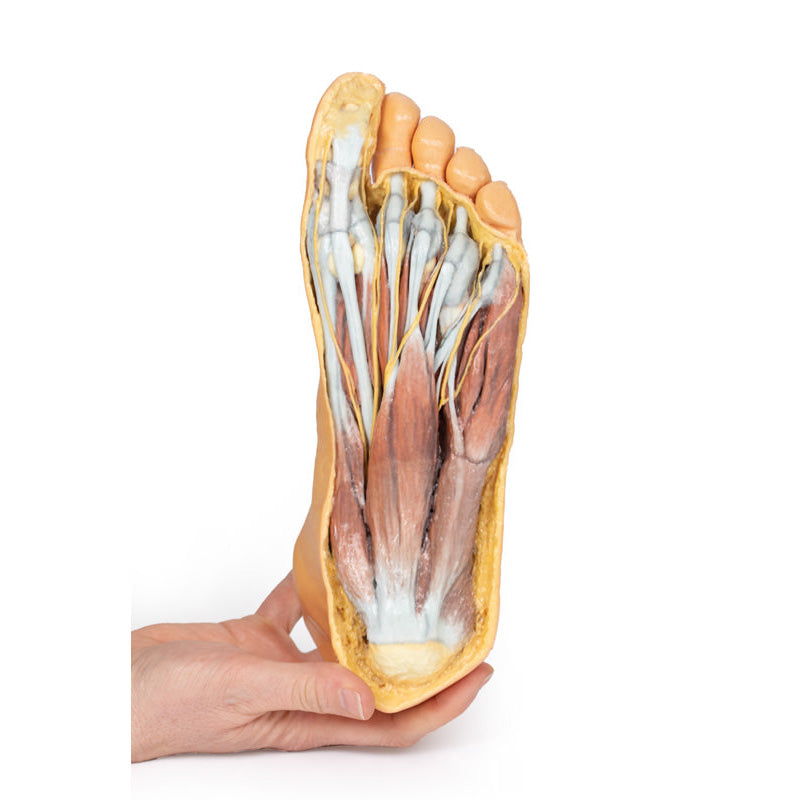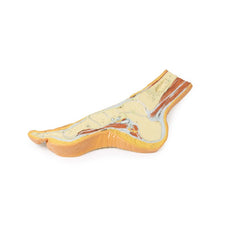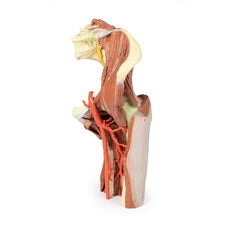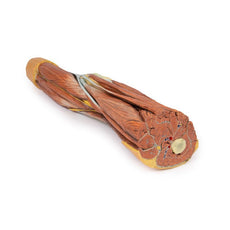Your shopping cart is empty.
3D Printed Foot, Plantar surface and superficial dissection
The flexor digitorum brevis muscle and tendons overlie the flexor digitorum longus tendon, although both the divisions of the tendon and the lumbricals muscles are visible approaching the flexor sheaths. The superficial branches of the medial and lateral plantar nerves radiate from the margins of the flexor digitorum brevis muscle, and can be seen dividing into the common and proper plantar digital branches.
At the margins of the plantar dissection, both the abductors and flexors of the hallux and fifth digit are exposed, with both medial and lateral heads of the flexor hallucis brevis inserting into prominent sesamoids on either side of the flexor hallucis longus tendon.
On the dorsum, a window of skin has been removed to expose the dorsal fascia of the foot and underlying tendons from the anterior compartment of the leg. The dorsal fascia has been removed over the lateral metatarsals to expose the extensor hallucis brevis, the tendons of the extensor digitorum longus and brevis, and the dorsal interosseous muscles.
At the proximal end of the specimen, the distal tibia and fibula are visible joined by the interosseous membrane. The tendons and muscles of the leg compartment muscles are visible, including the tendocalcaneous. Both the anterior and posterior tibial arteries (with accompanying veins) are visible in cross section, as are the superficial fibular nerve and tibial nerve.
Download Handling Guidelines for 3D Printed Models
GTSimulators by Global Technologies
Erler Zimmer Authorized Dealer

8.0 lb
🎄 HOLIDAY SAVINGS - Ends Dec 31 🎄
Discount has been automatically applied for this item.
3D Printed Foot, Plantar surface and superficial dissection
Item # MP1910
$1,230.00
$1,367.00
You save $137.00
Need an estimate?
Click Add To Quote

Features & Specifications
-
by
A trusted GT partner -
FREE Shipping
U.S. Contiguous States Only -
3D Printed Model
from a real specimen -
Gov't pricing
Available upon request
Frequently Bought Together
3D Printed Foot - Plantar surface & superficial dissection on the dorsum
This 3D printed specimen is a left foot with superficial structures exposed on the dorsum, and the superficial layer of muscles and nerves on the plantar surface. The anterior portion of the plantar aponeurosis has largely been removed to expose the first layer of muscles. A small portion of the lateral band of the plantar aponeurosis is preserved with the attachment to the fourth metatarsal visible.The flexor digitorum brevis muscle and tendons overlie the flexor digitorum longus tendon, although both the divisions of the tendon and the lumbricals muscles are visible approaching the flexor sheaths. The superficial branches of the medial and lateral plantar nerves radiate from the margins of the flexor digitorum brevis muscle, and can be seen dividing into the common and proper plantar digital branches.
At the margins of the plantar dissection, both the abductors and flexors of the hallux and fifth digit are exposed, with both medial and lateral heads of the flexor hallucis brevis inserting into prominent sesamoids on either side of the flexor hallucis longus tendon.
On the dorsum, a window of skin has been removed to expose the dorsal fascia of the foot and underlying tendons from the anterior compartment of the leg. The dorsal fascia has been removed over the lateral metatarsals to expose the extensor hallucis brevis, the tendons of the extensor digitorum longus and brevis, and the dorsal interosseous muscles.
At the proximal end of the specimen, the distal tibia and fibula are visible joined by the interosseous membrane. The tendons and muscles of the leg compartment muscles are visible, including the tendocalcaneous. Both the anterior and posterior tibial arteries (with accompanying veins) are visible in cross section, as are the superficial fibular nerve and tibial nerve.
Download Handling Guidelines for 3D Printed Models
GTSimulators by Global Technologies
Erler Zimmer Authorized Dealer
These items normal warranty are two years, however the warranty doesn’t cover “wear and tear”. The manufacturer does have 100% quality control on these models.
The models are very detailed and delicate. With normal production machines you cannot realize such details like shown in these models.
The printer used is a color-plastic printer. This is the most suitable printer for these models.
The plastic material is already the best and most suitable material for these prints. (The other option would be a kind of gypsum, but this is way more fragile. You even cannot get them out of the printer without breaking them).The huge advantage of the prints is that they are very realistic as the data is coming from real human specimen. Nothing is shaped or stylized.
The users have to handle these prints with utmost care. They are not made for touching or bending any thin nerves, arteries, vessels etc. The 3D printed models should sit on a table and just rotated at the table.
The models are very detailed and delicate. With normal production machines you cannot realize such details like shown in these models.
The printer used is a color-plastic printer. This is the most suitable printer for these models.
The plastic material is already the best and most suitable material for these prints. (The other option would be a kind of gypsum, but this is way more fragile. You even cannot get them out of the printer without breaking them).The huge advantage of the prints is that they are very realistic as the data is coming from real human specimen. Nothing is shaped or stylized.
The users have to handle these prints with utmost care. They are not made for touching or bending any thin nerves, arteries, vessels etc. The 3D printed models should sit on a table and just rotated at the table.

by — Item # MP1910
3D Printed Foot, Plantar surface and superficial dissection
$1,230.00
$1,367.00
Add to Cart
Add to Quote











































